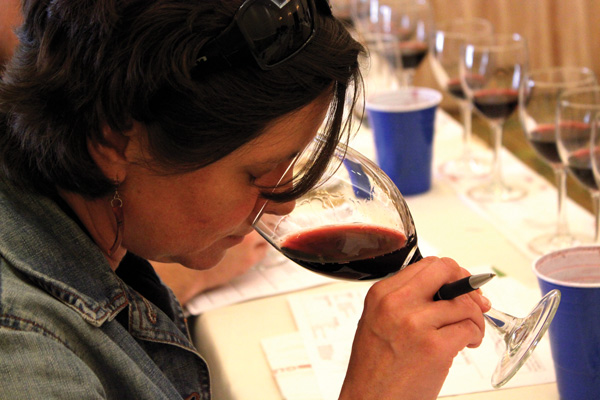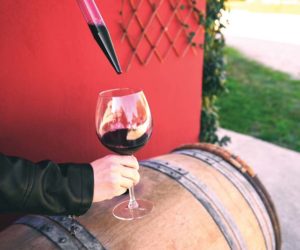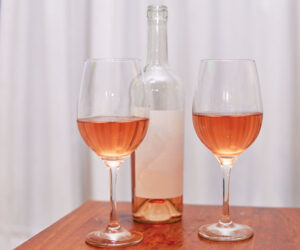Q I’m super excited to be heading to Bordeaux, France, this coming spring (COVID revenge travel, here we come!) and of course we’re planning on hitting a number of wineries. One of the events we’ll be attending (and maybe more) has an opportunity to do barrel tastings of some of the chateau’s newest wines. I’m somewhat experienced with tasting my own young wines (I mostly make fruit-based wines in Missouri) so I would love some advice on how to approach these kinds of very serious wines at such a young stage in their lives. My husband and I are pretty experienced Bordeaux drinkers; but what should we focus on: Fruit structure, acidity, length, etc.? Also, what are the things that might be different tasting wine less than a year old in barrel vs. something like which we typically would drink in a Bordeaux, namely something that’s “finished wine” with at least four or five years of age.
Emily Catton
Jefferson City, Missouri
A I apologize in advance for the lengthy response, but this is a fantastic question and I really wanted to flesh out my answer for you. You’re absolutely right to realize that tasting new and developing wines is vastly different than tasting the finished and bottled wines we are all accustomed to. As wines gain bottle age they change even further, developing secondary and tertiary “bottle bouquet” aromas. Before bottling, wine is in a whole different world.
In general, over time, new wines, both red and white, increase in clarity as sediment falls out. They generally decrease in acidity and harshness as malolactic fermentation occurs and dissolved carbon dioxide evolves out of the wine. Wines become rounder and more “together” in the mouth as tannins condense and fall to the bottom of the aging vessel. Aromas develop from very primary fruity and funky during fermentation to become the mature and seamless aromas one associates with finished, bottled wine. The length and finish of a new wine tend to be shorter and will lengthen with age.

Below are some details about what to look for at various stages of a wine’s life — depending on which barrels they show you (and when you visit), the new wine probably will be about five months old. The below will help you (and fellow readers) assess young wine at any stage. Whether tasting after a pumpover during harvest in Chile or barrel tasting at En Primeur in France (or after a racking of raspberry wine in Missouri), hopefully the below information can give you an idea of what to expect and how the wine will differ from something that’s “finished” and in the bottle.
Color
Fermenting wine: Newly crushed wines have the highest level of turbidity and sediment they ever will due to all those bits of grape pulp and skin floating around. As a result, the true color of the wine-to-be is quite masked. Due to the turbidity and sediment, this is not a very pretty stage for any wine and, therefore, it’s difficult to judge what the pressed-off and settled color will be. Experience working with the same grapes over many harvest seasons will give you the experience needed to be able to predict final color.
1–6-month-old wine: Once a wine is dry and reds have been pressed off and settled, it’s easier to get a look at the color. Very young whites will still be very turbid, so samples need to be centrifuged in order to really get a good look. Be aware that, in red wine, suspended lees are almost a kind of whitening agent; the real wine behind the lees will always settle out darker than a leesy sample might suggest.
6–12-month-old wine: Color is very stable at this point and most reds exhibit the kind of color they’ll carry through the next five years or so. Well-settled whites will exhibit the color they’ll have for about the next two to three years; white wines oxidize and become more brown-hued after about five years in the bottle. White wines on a lees-stirring program will still be turbid, making color difficult to judge.
Clarity
Fermenting wine: As mentioned earlier, fermentation is the most turbid a wine will be. Grape skin, pulp particles, and yeast cells all contribute to a juice or must that is impossible to see through. Don’t worry, time and gravity will take care of most if not all of this. Experienced tasters and winemakers will know but general consumers will often be very turned off by cloudy wine.
1–6-month-old wine: The wine will still be very turbid, especially if malolactic fermentation (MLF) happens and the weather is cold; suspended bacterial cells in a prolonged MLF will continue to make the wine appear cloudy or hazy.
6–12-month-old wine: Wine should be “falling bright” as gravity causes particulate matter to fall to the bottom of the barrel. It’s still unlikely the wine will be completely clear at this point, especially if lees are kicked up due to purposeful lees stirring or even during routine monthly sulfur dioxide additions and topping.
Aroma
Fermenting wine: This is a fun stage to experience as many types of smells from fabulous (think loads of ripe fruit percolating out of the fermenter) to funky (think of a microbial house party with wildly reproducing yeast and bacteria). The finished wine smells almost nothing like a wine during active fermentation.
1–6-month-old wine: Experienced tasters and winemakers know what to look for but general consumers are often very put off by wines at this stage. MLF can confuse and obfuscate positive and typical finished wine aromas. Compounds like hydrogen sulfide (rotten eggs) or other sulfur-containing compounds can contribute to a reduced (slight hydrogen sulfide) aroma during the early stages of a wine’s life. The wine can smell leesy and microbial; this is a classic stage for malolactic aromas like hamster-cage and mouse-pee that, though they will go away, are temporarily alarming. Though you can certainly smell some great, bright primary fruit aromas at this stage it is usually a very awkward time for most wines.
6–12-month-old wine: The wine will only now begin to take on more of the character of a finished product. The longer MLF goes on, the younger and more unfinished the wine will seem because the dissolved carbon dioxide and reproducing bacteria will keep it in a fermentative and unsettled state. In later months, the wine is “growing up” and turning slowly into what it will be in the bottle. Aromas go from fresh and very fruity to more complex and integrated, especially if oak extraction is involved. In barrel-aged red wines look for
spice, vanilla, clove, leather, and black tea beginning to make an appearance.
Taste, Mouthfeel, and Finish
Fermenting wine: As in the aroma category, this is an adventurous stage to taste! You’ll get sweet, sour, and everything in between as the yeast turn the grape sugar into alcohol and carbon dioxide. As you might expect, wine during primary and secondary (malolactic fermentation) can carry a large amount of dissolved carbon dioxide gas, such that it will feel harsh on the palate and not smooth at all. Tannin content will be minimal at this stage because in red wines the grape skins are just beginning to extract into the aqueous, then increasingly alcoholic, solution.
1–6-month-old wine: The wine is now pressed so all of the tannins that come from the grape (some will come from the barrel, later) are in the wine. The tannins in reds will taste harsh, rough, and aggressive at this stage, unless the grape is a low-tannin variety like Pinot Noir. If the wine is going through MLF it will still taste sour and gassy at this stage, which will make the tannins appear even rougher. Alcohol + tannin + carbon dioxide + acidity all enhance/increase the sensation of the other, which is one of the reasons young wine is so unpleasant to taste.
If the wine is going through MLF it will still taste sour and gassy at this stage, which will make the tannins appear even rougher.
The wine will taste disjointed, as if the parts have not really begun to hang together yet. It takes a lot of mental gymnastics to try to get a sense of what a wine will become at this time. At six months in the barrel, if new wood, the oak will have begun to make its presence felt. Approaching six months, tannins in red wines will begin to condense into larger molecules, appearing smoother on the palate. The largest tannin molecules may even fall out of solution and accumulate as lees and sediment in the bottom of tanks and barrels.
6–12 month old wine: By now the elements that will make the final wine have begun to really come together, and because so much has “settled down” (carbon dioxide levels have subsided, MLF is over, etc.) it’s easier to pick out the taste elements that will stay with the wine as it ages further and as it’s bottled and bottle-aged. The wine will feel smoother in the mouth as tannins condense and mature. The small amounts of oxygen released into a barrel or in a tank through micro-oxygenation will help keep the wine on a forward-moving trajectory towards aging and will prevent (hopefully!) a return to a reductive state. The finish will start to lengthen though it’s nowhere near what it will be at 18 months to two years in barrel.
It’s important to realize that when barrel tasting, you may only be tasting one barrel out of many that may make its way into a final blend. Each barrel is like its own mini tank— even if you put the same wine into it, in six months it can be very different from its siblings, especially if different coopers and toast levels are used. Be sure to ask what the situation is; you may be tasting wine from a barrel that has recently been homogenized and put back down to barrel in a group or you may be tasting a barrel in which the wine has been residing for six months or more. If the latter is the case, it can be very interesting to compare the same original wine across different kinds of barrels. Do be a cautious consumer — it’s unlikely that any winery will just randomly let the public in and wander around tapping any old barrel. They will probably present some of the best stuff to you, and the “barrel sample” may be a very carefully composed blend!
I hope the above has been helpful to you for your travels as well as your own winemaking. I wish you the best of luck on your travels and I’m sure that you will find plenty of tasting joys that will give you a wealth of new information about how wines develop!
Q I really hate bottling. I pretty much detest almost everything about it, from the hassle of cleaning to assembling all of the parts and pieces of gear and supplies. The only thing I like about it is having my friends over while I feed them pizza and beer (no wine allowed on bottling day) and press gang them into giving me a bunch of free labor. Then there are the times when I have a corked bottle turn up after all that hard work . . . I could go on! Sorry to complain. I’ve been contemplating kegging my wine — I know it’s maybe a little weird and it does feel like unknown territory. I’ve never homebrewed beer but some of my buddies have, so I feel like I could give it a try. What do you think about kegged wine — yay or nay?
Arnold Alexander
Bend, Oregon
A Hey, I’ve been there . . . a couple of years ago I also entered into unknown territory. After years of bottling one of my commercial Pinot Noirs in Stelvin screwcaps, I embarked on an adventure into the land of wine kegs, or “wine-on-tap.” I kept hearing from sommeliers and restaurant staff how by-the-glass programs were exploding for them and wine-on-tap was leading the way. Consumers liked the environmentally friendly message, they liked the often higher-end choices of wine on offer, and, ultimately, they liked the quality they were tasting in the glass.
The restaurant owners and staff loved the fact that they didn’t have to toss half-used bottles of open wine that hadn’t sold, didn’t have empty glass bottles to recycle, and that their staff was more efficient now that the “cork popping” tableside ceremony was happening less and less often.
But, as a home winemaker, what if you’re not planning on selling your wine like I do and therefore the above reasons to keg your wine don’t really apply to you? Rest assured there are still plenty of reasons for home winemakers to take their wine for a spin in the stainless container. So, if you’re not going to be selling your wine like I do and still want to know why you should have yourself a wine kegger, check out these compelling reasons:
A glass of fresh wine every time, from first glass to last.
- Ever been to a restaurant, ordered a wine by the glass with which you are familiar, only to have it come to the table tasting tired, oxidized, and ho-hum? Chances are you were served from a bottle that had been open since yesterday, or worse, for longer! When you buy (or serve at home) wine from a keg, pushed out with an inert gas, you know the last glass will be as nice as the first.
No oxidation and no cork taint.
- Since there is no cork involved here there is no chance of cork taint from that source. Since you don’t have to worry about the integrity of a plug of tree bark, there’s less chance of air coming in from that source. Every glass tastes like you meant it to taste.
Less “bottle shock”
- Think about it this way . . . kegging up wine is more likebottling in “large format” (3- to 5-L) big bottles than your standard 750-mL model. The smaller the vessel, the larger the ratio of oxygen-to-wine. I believe that bottle shock is very much about big slugs of oxygen getting into your wine and then chewing its way through it as it “figures itself out” (I know, that’s a touchy feely way of putting it, but forgive me). By packaging in bigger vessels, you lower that oxygen-to-wine ratio and therefore the oxygen-equilibrating blowback of bottle shock.
It’s the “green” choice — massive reduction in carbon footprint compared to bottles
- This is a reason that everyone can get behind!
- Reusable kegs can be used for 30+ years.
- No waste to the landfill: Each reusable steel keg saves over 2,340 lbs. (1,060 kg) of trash from the landfill over its lifetime (source: www.freeflowwines.com).
To get you up to speed on the (limited, I promise!) gear, I really recommend you check out Tim Vandergrift’s excellent piece “Kegging Your Wine” at our website, (https://winemakermag.com/technique/1408-wine-on-tap). He really breaks down the details for you and walks you through the process. Probably the easiest way to get started is to use a Cornelius keg, a.k.a., “Corny keg,” as Tim suggests. If you can borrow some of the set-up bits and bobs from one of your brewing friends, that makes it even easier and more affordable. Kegging wine can have a ton of benefits . . . and you don’t need to invite a gang of friends over to help, though you can still certainly have a pizza and beer night (with some tastes from your keg) afterwards!






